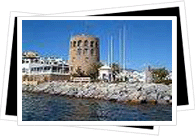For a trip back in time, visit Marbella’s Old Quarter (Casco Antiguo). A visit to the Old Quarter is something that you should not miss.
Marbella is a thoroughly modern resort town, but a walk through the Casco Antiguo shows that Marbella still retains a hold on its glorious but turbulent past. Here, you could clearly see what an old fishing town would look like. Indeed, the Old Quarter still looks like a traditional Andalucian town by the sea – plazas filled with trees, lovely churches, white washed houses and buildings with elaborate wrought metal railings, Muslim-inspired decoration and cobblestone streets.
The center of the Old Quarter is the Plaza de los Naranjos (Orange Square). It is so named because of the many orange trees growing there. The plaza is surrounded by a lot of notable buildings and structures- the town hall or ayuntamiento (16th century), the Renaissance fountain (15th century) and the Casa del Corregidor (17th Century) are just but a few. There is also a number of interesting shops around the Plaza.
The Plaza is a great place to starts your wanderings across the Old Quarter – it is romantic, with its narrow streets, tree-lined squares and balconies adorned with flowers. The narrow and winding streets show the town’s Moorish influence, while the trees in the squares were planted by the conquering Christians.
Here are some places that you should look into at the Old Quarter:
- Avenida del Mar, which has a beautiful promenade along the sea
- The Iglesia de Santa Maria, which stands in the Plaza de los Naranjos. A beautiful red stone entrance done in the Baroque style adorns the main façade. This was built in 1618 and its interior underwent restoration after the Civil War in 1936. You can find an old but amazingly, functional organ. It is the most important of all organs built in Spain for the last 125 years. It fills the chapel with the sonorous and worshipful sounds – it has four manual keyboard and a 36-note pedal.
- The Santa Maria de la Encarnacion, which was built in 1505. The parish was rebuilt in 1712, with Pedro del Castillo and Salvador Gávez spearheading the construction. The construction and sculpting of the main façade was finished in 1756. This is located in the Plaza de la Iglesia, another pretty square that is also lined with fruit trees that provide welcome shelter for those who want to rest from their meanderings.
- Las Murallas del Castillo, which holds the remains of the Arab castle and the old city walls. Built in the 10th century during the Caliph period, this castle was once surrounded by towers that served as lookouts. Sadly, all the towers are gone, victims of the ravages of time. Currently, part of the castle and its walls are being restored.
- The Old Governor’s House, which was built in 1552 and still has the original stone façade that is decorated with a three arched balcony and some shields.
- CouncilChambers, this is located within the Town Hall. The chambers are divided into two floors. The second floor is fascinating – its walls are covered with murals that date back to 1572, the ceiling is designed with carvings in the Neo Mudejar style.